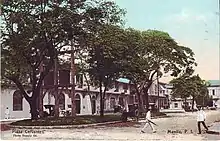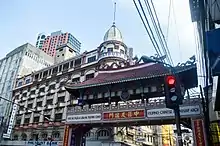Plaza de Cervantes | |
|---|---|
| Public square | |
| Former name(s): Plaza San Gabriel, Plaza Vivac | |
 | |
| Dedicated to | Miguel de Cervantes |
| Owner | City of Manila |
| Location | Binondo Manila, Philippines |
| Coordinates: 14°35′49.1″N 120°58′33.2″E / 14.596972°N 120.975889°E | |
Plaza de Cervantes is a public square in Binondo, Manila, bounded by Quintin Paredes Street (formerly Calle Rosario) to the east and Juan Luna Street (formerly Calle Anloague) to the west, near the Estero de Binondo. Dedicated to Spanish writer Miguel de Cervantes, it is one of three main plazas in Binondo, located between Plaza Moraga to the south and Plaza San Lorenzo Ruiz to the north.
History

Plaza de Cervantes was originally called Plaza San Gabriel, named after the Misión San Gabriel, a mission of the Dominican Order which evangelised to the area's Chinese community. It later became Plaza Vivac as the area grew to become a commercial center, and later received its current name as it became the financial center of Manila.[1] The plaza was damaged in the 1863 Manila earthquake, where the ground reportedly opened and sulfuric fumes came out.[2]
Originally covered with cobblestone,[3] by the early years of the American colonial period the plaza was dominated by low-rise commercial buildings, which author and Thomasite Paul T. Gilbert likened to a scene out of Othello or The Merchant of Venice.[4] In 1916, a monument was installed in the plaza to Tomás Pinpin, the first Filipino printer, although infrastructure improvements initiated by the colonial government led to businesses moving out of the plaza and to the nearby Plaza de Goiti (now Plaza Lacson) and Escolta Street.
While Binondo was largely spared from the Battle of Manila in 1945, and economic activity recovered thereafter, the area around the plaza started declining around the 1960s, when most business activity shifted from Manila to Makati and Cubao in Quezon City. With increased traffic congestion in the area, the monument to Tomás Pinpin was relocated to Plaza Calderón de la Barca (now Plaza San Lorenzo Ruiz) in 1979,[5] when the plaza was cleared to make room for more parking space.[6]
In 2014, the Megaworld Corporation announced that it was going to redevelop and rehabilitate the plaza and its immediate area as part of the construction of a new condominium building, the 47-story Noble Place.[7] A garden is expected to be installed once the rehabilitation is complete.[8]
Surrounding buildings and structures

Owing to its status as a financial center in its heyday, a number of notable buildings and structures have been built in and around the vicinity of Plaza de Cervantes, including some of Manila's tallest buildings at the time. The most notable building currently standing is the Mariano Uy Chaco Building, built in 1914 and said to be Manila's first skyscraper. Designed by American architect Samuel E. Rowell in the Art Nouveau style,[9] and including a distinctive clock tower, it was the headquarters for Uy Chaco and Sons, a hardware company which imported goods from the United States for local distribution.[10] Beside it is the Geronimo de los Reyes Building, also known as the Edificio A. Soriano. Designed by Juan Nakpil, the building later came to the ownership of industrialist Andrés Soriano, becoming the headquarters for his eponymous conglomerate and later buying out neighboring buildings for its expansion, with the expansions designed by Andrés Luna de San Pedro.[11] The building at the time also hosted the Franco-era Spanish consulate, owing to Soriano's Francoist sympathies,[12] as well as the law firm Dewitt, Perkins, and Ponce-Enrile, where Alfonso Ponce Enrile, father of Juan Ponce Enrile, was a partner.[13] Damaged in the Battle of Manila and subsequently restored,[14] the building is presently abandoned.

Across from the Mariano Uy Chaco Building on the corner with Plaza Moraga was the Insular Life Building, built on the site of a former Chinese cemetery and rising taller to become Manila's tallest pre-war structure.[15] Likewise designed by Andrés Luna de San Pedro, it was known for the distinctive eagle on its pinnacle.[16] Originally built as the headquarters of the Insular Life Assurance Company, the Philippines' first own life insurance company, it also hosted the trading floor of the Philippine Stock Exchange,[17] as well as the studios of colonial-era radio station KZRM (now DZRB-AM).[18] Also damaged in the Battle of Manila and subsequently restored,[14] the building was later demolished after Insular Life relocated to Makati in 1962.
Several financial institutions have also been located in Plaza de Cervantes at some point in their history. In 1892, the Banco Español-Filipino, now Bank of the Philippine Islands (BPI), relocated to 4 Plaza Cervantes from their first headquarters in Intramuros, the property being owned at the time by the Dominicans. BPI still maintains a branch today on the same site. Meanwhile, the Hongkong and Shanghai Banking Corporation (HSBC) established its first branch in the Philippines — the first foreign bank to do so — at the corner of the plaza and Calle Rosario on November 11, 1875, later moving to a new building on the other end of the plaza in 1922. Although HSBC moved out in 1971 in favor of moving to new offices in Makati, and the building was in a state of disrepair for several years thereafter, the building was restored and now houses the 1919 Grand Café.[19] Philtrust Bank, meanwhile, is the current owner of the Mariano Uy Chaco Building, maintaining a branch on the building's ground floor.
A number of government offices are also located in the plaza's vicinity. The National Archives maintains administrative offices behind the plaza at the Juan Luna Building at the corner of Juan Luna Street and the Muelle de la Industria, while the Land Management Bureau (LMB) formerly maintained its headquarters on the site of the former Insular Life Building. In 2018, both buildings, as well as the BPI building, were damaged in a fire that started in the LMB offices, causing ₱100 million worth of damage to equipment and destroying several important documents, including land titles, held in storage at the LMB.[20] The LMB has since relocated to a new headquarters along Quezon Avenue in Quezon City,[21] and the old headquarters remains abandoned.
See also
References
- ↑ Rizal, José (1912). "Smiles and Tears". The Reign of Greed (El Filibusterismo). Translated by Charles Derbyshire. Manila: Philippine Education Company. p. 254. Archived from the original on July 16, 2019. Retrieved April 9, 2020.
- ↑ Laya, Jaime C. (September 4, 2017). "Manila 1870, seven years after the earth moved". Manila Bulletin. Archived from the original on June 21, 2019. Retrieved April 9, 2020.
- ↑ "Atienza orders artifacts secured". The Philippine Star. PhilStar Daily, Inc. December 19, 2006. Retrieved April 9, 2020.
- ↑ Gilbert, Paul T. (1903). "All About the Town". The Great White Tribe in Filipinia. Cincinnati: Jennings and Pye. p. 32. Archived from the original on October 1, 2019. Retrieved April 9, 2020.
- ↑ "The New Plaza San Lorenzo Ruiz". The Historical Marker Database. Archived from the original on September 17, 2013. Retrieved April 9, 2020.
- ↑ Alcazaren, Paulo (April 27, 2002). "Plaza Lorenzo ruins?: We need a miracle to save Plaza Lorenzo Ruiz". The Philippine Star. PhilStar Daily, Inc. Archived from the original on January 3, 2017. Retrieved April 9, 2020.
- ↑ "Megaworld to rehabilitate Plaza Cervantes". The Standard. March 14, 2014. Retrieved April 9, 2020.
- ↑ Samaniego, Theresa S. (January 28, 2017). "Breathing new life into Plaza Cervantes". Philippine Daily Inquirer. Archived from the original on January 27, 2017. Retrieved April 9, 2020.
- ↑ De Guzman, Nicai (March 18, 2016). "Neighborhood Guide: Escolta". Spot.PH. Summit Media. Archived from the original on August 31, 2017. Retrieved April 9, 2020.
- ↑ Tumang, Adrian (December 10, 2018). "These are 7 historic commercial landmarks you should know about". BluPrint. One Mega Group. Retrieved April 9, 2020.
- ↑ "E. Vazquez Prada: He manages the new Mortgage Bank of the Philippines". The American Chamber of Commerce Journal. Manila: American Chamber of Commerce of the Philippines: 54–55. 1940.
- ↑ Rodao, Florentino. La Comunidad Española en Filipinas, 1935-1939 [The Spanish Community in the Philippines, 1935-1939] (PDF) (PhD) (in Spanish). University of Tokyo. ISBN 978-84-617-0848-2.
- ↑ Orteza, Bibeth (February 26, 2012). "A life in the day of Juan Ponce Enrile". Philippine Daily Inquirer. Archived from the original on March 3, 2016. Retrieved April 9, 2020.
- 1 2 Ronquillo, Bernardino (1947). "Manila Rises From The Ruins; Rebuilding Gets Started". The American Chamber of Commerce Journal. Manila: American Chamber of Commerce of the Philippines: 5–6.
- ↑ De Guzman, Nicai (August 15, 2017). "9 Beautiful Heritage Buildings Manila Has Lost". Esquire Philippines. Summit Media. Archived from the original on March 21, 2020. Retrieved April 12, 2020.
- ↑ Cruz-Araneta, Gemma (May 30, 2018). "S & D in Binondo". Manila Bulletin. Retrieved April 12, 2020.
- ↑ Fabonan III, Epi (January 27, 2017). "Binondo rising". The Philippine Star. Archived from the original on September 21, 2018. Retrieved April 12, 2020.
- ↑ Fernandez, Erwin S. (2017). The Diplomat-Scholar: A Biography of Leon Ma. Guerrero. ISEAS Publishing. p. 57. ISBN 9789814762229. Retrieved April 12, 2020 – via Google Books.
- ↑ Reyes, Isidra (November 9, 2018). "Binondo's heritage jewel has been transformed into a grand café". ABS-CBN News and Current Affairs. Archived from the original on March 4, 2020. Retrieved April 9, 2020.
- ↑ Rivas, Ralf (May 28, 2018). "Land titles, P100 million worth of equipment gone in Binondo fire – DENR". Rappler. Archived from the original on November 24, 2018. Retrieved April 9, 2020.
- ↑ Ruiz, Ellalyn de Vera (March 21, 2019). "LMB opens new office in Quezon City". Manila Bulletin. Archived from the original on April 10, 2020. Retrieved April 10, 2020.

